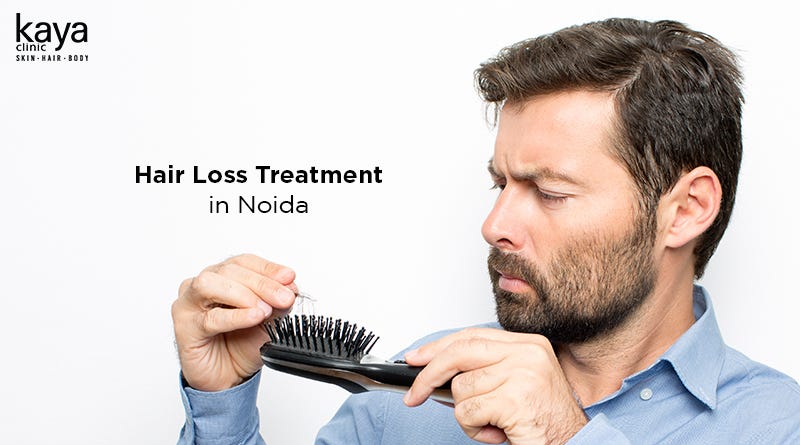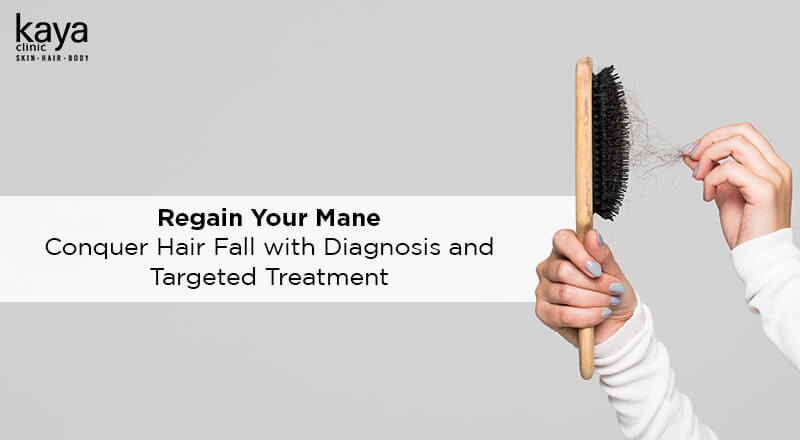Hair Loss: Causes, Treatments And Prevention

Table Of Content
- About Hair Loss
- Stages of Hair Growth
- Reasons for Hair Loss
- Hair Regrowth Treatment Options
- Kaya’s Hair Regrowth Treatment
- Conclusion
- FAQs About Hair Loss Treatment
About Hair Loss
Losing hair is part of a normal cycle of growth and replacement. Hair follicles go through the growth and resting cycle in a non-synchronized way. Genetics is the most common cause of hair loss among both, men and women. In fact, heredity accounts for 95% of all the cases of alopecia (baldness). The remaining 5% of the cases can depend on a number other factors like diet, stress, illness, medications and more.
The most known cause of hair loss is a hereditary condition called male-pattern baldness or female-pattern baldness. It usually occurs gradually and in predictable patterns — a receding hairline and bald spots in men and thinning hair in women. It's called androgenetic alopecia. It is caused by DHT, a by-product of testosterone.
The size reduction of hair follicles is one of the known common causes of hair loss amongst both men and women. Simply meaning, the anagen stage of hair growth gets shorter, and the resting (telogen) stage gets longer. Thus, resulting in thin, extremely short hair while also leaving many follicles empty of hair shafts.
This pattern of hair loss is common only in the front and on top because that's where hormone-sensitive follicles live. The follicles on the sides and back of the head aren't affected by DHT and usually stay healthy.
Stages of Hair Growth
Anagen
At this stage i.e. the growth phase, hair grows about half an inch per month. This phase usually lasts between 2 and 8 years. The process of hair starts when the follicle stem cells begin their work. Thereafter, the dermal papilla, the permanent part of the follicle, stimulates the hair matrix cells making them grow wildly and become pigmented. This creates a new hair shaft. 90% of hair cells are in this phase of growth during a given time.
Exogen
The Exogen stage represents the period from when a resting hair reaches its terminal position in the follicle to when it finally detaches. The resting hair is gradually loosened resulting in the shedding of the hair.
Anagen finished
The new hair extends beyond the surface of the skin and keeps growing. The hair shaft fully matures.
Catagen
At the end of the growth period, hair follicles prepare themselves for a resting phase. This transition period of a hair follicle from growth to rest is called the catagen stage. The catagen stage lasts about 1 to 2 weeks or so. During this phase the deeper portions of the hair follicles start to collapse.
Telogen
The resting stage when hair regrowth stops temporarily. This resting stage can last up to five months. The hair is shed at the end of this period. If the follicle is healthy, a new shaft begins to grow and the cycle begins again.
Reasons for Hair Loss
When it comes to finding reasons about why an individual loses his or her hair, there are plenty of reasons that are available.
- Excessive Stress/ Hormonal Changes: People can have hair fall due to excessive stress as well pollution. There are people who lose hair because of hormonal changes and other hereditary problems.
- Drug medications, lack/excess of vitamins or minerals: They sometimes causes hair loss. Drugs used to treat high blood pressure, heart problems, depression, or gout; chemotherapy or radiation treatment for cancer patients; unusually high levels of vitamin A or low levels of iron or protein; for women, birth control pills can cause hair loss.
- Diseases/Infection: Thyroid disease severe infection, or flu; fungus infections such as ringworm of the scalp can also result in hair loss.
- Childbirth: For women, childbirth may cause temporary hair loss due to the changes that take place in the body. In some cases, adults or children may have a condition known as trichotillomania, in which there is a compulsion to pull out scalp hair, eyebrow hair, or eyelashes.
- Telogen Effluvium: It is a common type of diffused hair loss among women. With telogen effluvium, thinning hair or hair shedding is caused when majority of scalp hair are shifted into the Telogen phase of the hair growth cycle. This means that more hair is in the resting stage than usual, and fewer hair follicles are available to grow new hair in the Anagen phase. This slows down the hair growth cycle and results in a gradual shedding of hair.
- Chemotherapy-Induced Alopecia: Chemotherapy is thought to cause hair loss by attacking rapidly diving cells in the body, including the dividing hair matrix cells, one of the fastest growing cell populations in the human body. It most commonly affects the scalp, although armpit and pubic hair, eyebrows, and eyelashes may also be lost. Chemotherapy forces growing follicles into the catagen stage. The hair shaft doesn't develop properly, so the hair breaks and falls out. The cause of hair loss associated with molecularly targeted agents has not been thoroughly investigated. Eventually, when chemotherapy is over, the follicles regenerate. Healthy, new hair regrows eventually. Though in the short term, chemotherapy causes near total hair loss.
- Alopecia Areata: It is an autoimmune disease where sometimes a person's immune system attacks the cells of the growing hair bulb. The exact cause of alopecia areata isn’t known. However, it most often occurs in people who have a family history of other autoimmune disorders, such as type 1 diabetes or rheumatoid arthritis. Just as in chemotherapy, hair follicles are forced into the catagen phase. Hair breaks and falls out, usually in patches scattered across the scalp.Sometimes the immune system attacks only the hair bulb. In this case, the hair follicles regenerate when the immune system is brought under control.Alopecia areata is not related to a more serious condition known as cicatricle alopecia, in which the immune system attacks the stem cells in the bulge of the follicle. This results in permanent hair loss.
Hair Regrowth Treatment Options
Male/Female Pattern Baldness
Rogaine (topical minoxidil) and Propecia (finasteride) are the only FDA approved drugs to treat pattern baldness (hair loss resulting from hereditary causes).
Rogaine: Rogaine a topical solution, is applied directly by rubbing it onto the scalp where hair regrowth is desired. The minoxidil promotes blood flow to the hair follicles and increases both the size of the follicles and the diameter of the hair shaft. This stimulates hair regrowth and prolongs that growth. Follicles that had, over time, become shrunken and were therefore producing finer hairs should then become larger and subsequently produce thicker hair.
Only about 10% to 14% of the people who try this lotion experience hair regrowth. However, Rogaine lotion can help to slow hair loss.
Propecia: Propecia is the first pill that can treat male pattern hair loss. It is a prescription based product and thus, should be given under a doctor's care. For effective, maintained and sustained results, the treatment should not be discontinued.
Permanent Hair Loss: Permanent hair loss can also be treated by hair replacement procedures, such as hair transplantation methods namely micro-grafting, slit grafting, punch grafting and also by scalp reduction. The type of hair loss as well as the patient's circumstances and desires determine which hair replacement procedures are most suitable.
1. Stem cell therapy:
Human hair grows out of follicles present on the scalp. Damaged or dead follicles prevent new hair from growing. Stem cells help to stimulate these cells. They help in growing new follicles when transplanted onto the scalp.
Scaffolding which is enriched with stem cells also has a requisite growth factor. It is injected onto the scalp, which makes the hair follicles orient themselves, and develop in the right direction. It helps promote hair growth and fight baldness.
While aging, the follicles tend to shrink and stop responding to the chemical signals given to it. Thus hindering the process of hair regrowth. The follicle stem cell sends off chemical signals to the shrunken follicles. This, in turn, helps in regenerating and growing healthy hair.
A revolutionary hair loss treatment for hair regrowth, the stem cell therapy encourages new hair growth within 3 to 4 months of therapy. Unlike other hair fall treatments, it is absolutely safe and effective procedure for both, men and women.
Stem Cell therapy for Hair Regrowth is an advanced, non-surgical procedure to regrow hair follicles that results in healthy hair growth. These stem cells are capable of renewing themselves through cell division, sometimes after long periods of inactivity - thus helping in stimulation of long dead hair follicles in areas of baldness.
2. Intensive Hair Root Therapy for Hair Regrowth
There can be multiple reasons and conditions under which hair loss can be experienced. Lack of vitamins, minerals or iron in the body, age, pollution, heredity, stress, lack of sleep, hormonal imbalance and illness are some of the many. Hair treatment therefore becomes imperative to get the hair back to its normal health.
Intensive Hair Root Therapy is one of the efficient ways of treating hair loss in men as well as women. This hair treatment checks hair loss and allows hair to grow by supplying vital nutrients directly to the root of the hair. These vital nutrients are FDA approved and comprise natural plant extracts and vitamins that stimulate hair regrowth. The nutrients are delivered to the hair roots through microinjections that are relatively painless.
Known to be a proven effective solution, this hair treatment has helped patients experience positive results within 2-3 months of starting the procedure.
3. PRP Treatment for Hair Loss
Platelet rich plasma (PRP) is concentrated blood plasma that contains approximately 3 to 5 times the number of platelets found in normal circulating blood. In addition, it contains platelet-derived growth factor (PDGF), vascular endothelial growth factor (VEGF), transforming growth factor (TGF) and other bioactive proteins that aid in wound healing and possibly hair growth.PRP (Platelet Rich Plasma) therapy is an advanced, non-surgical, therapeutic procedure to treat hair loss conditions amongst patients with requirements of hair growth stimulation.
The medical community through recent scientific research and technology found new understandings of wound and tissue healing. Through these scientific studies, they defined PRP as an all-natural autologous (derived from the patients own blood) medical procedure performed in physicians’ offices for scalp, skin, and hair stimulation.
Simultaneously, literature on the success of PRP is being published through multiple studies and research. The hair restoration community though still remains cautious about making claims for hair restoration using PRP, exclusively.
4. Hair Nutri Infusion Therapy
Under this technique charged ions are used to deliver a nutrient cocktail through the skin. This cocktail delivers vital nutrients that go beneath the skin and help prevent hair breakage and hair loss. It also involves following a Nutraceuticals and Balanced Diet, meaning a nutrition-led approach using nutritional supplements to nurture and protect fragile hair follicles. Nutraceuticals must always be used in conjunction with an optimal diet.
5. Laser Hair Treatment
The hair growth cycle consists of three phases: growth (anagen phase), resting (telogen phase) and shedding (catagen phase). Hair loss in androgenetic alopecia depends on a testosterone derivative in the skin, dihydrotestosterone (DHT). Laser Treatment is believed to increase blood flow in the scalp and stimulate metabolism in catagen or telogen follicles, resulting in the production of anagen hair.
Laser Treatment is a safe form of light/heat treatment under investigation for a variety of health indications. It is being used to treat the genetic forms of hair loss common in men and women, androgenetic alopecia or pattern balding.
Laser treatment is also called red light therapy, cold laser, soft laser, biostimulation and photobiomodulation.
During the process, the photons of light act on cytochrome C oxidase leading to the production of adenosine triphosphate (ATP). This is converted to cyclic AMP in the hair follicle cells, releasing energy and stimulating metabolic processes necessary for hair growth. The release of nitric oxide from cells leads to increased vascularisation to the scalp distributing nutrients and oxygen to the hair roots. Thus, preventing excessive build-up of DHT.
6. Hair Transplant
Hair loss problems can be caused due to several different reasons. While the process is curable and reversible in many cases, there are instances when new hair growth refuses to grow due to permanent damage to follicles and the scalp. These are the situations when Hair Transplant comes to the rescue.
Due to modern technology, hair transplant surgery has made hair restoration possible. But, before you opt for hair transplant one must know which hair transplant treatment is the most suitable for them. There are lot of different hair transplant surgeries being offered by various different clinics and doctors.
3 Types of Hair Transplant:
1. Scalp Reduction: Scalp reduction is one of the earliest hair transplantation methods. During this process, scalp form the balding area is surgically removed. Most of the time, the area removed is from the crown or the top of the head. Post removal, the scalp area that bears hair is stretched over to cover and replace the patch that has been removed.
The process is suitable mainly for people who have good quantity of hair on the back and sides of the scalp. Today though, scalp reduction is not often used due to the more advanced FUE and FUT hair transplant procedures.
2. Follicular Unit of Hair Transplantation: FUT stands for Follicular Unit Hair Transplantation are takes place through an intrusive medium. Follicular units are hair groupings as they occur naturally on the scalp and typically contain 1, 2, 3 or 4 hairs. It begins with the doctor cutting a strip of tissue from the scalp, before cutting it into thousands of follicular units. These units are then strategically placed around the head, after the doctor has created holes with recipient sites around the affected, bald areas. By means of the removal of a thin strip of scalp from the back of the patient’s head, hair follicles are taken from a donor area which is not susceptible to balding and dissected into individual grafts. They are then transplanted to the balding area of the scalp. As one can probably assume from the above, FUT is a very complicated technique although has the potential for some very fulfilling results.
3. Follicular Unit Extraction: The other method is the FUE method of hair transplantation Follicular Unit Extraction. It involves taking the individual Follicular Unit grafts from the back of the head one by one by cutting around it through a tiny specialized instrument or robotic machine and removing the hair follicles. The process can be tedious and will takes a few hours but is painless after a few numbing injections are given. Once removed from the donor area, the follicular unit is then transplanted.
Kaya’s Hair Regrowth Treatment
No more hair fall heart breaks! The Kaya Hair Revive and Fortify therapy deeply strengthens hair root, fibre and scalp to prevent breakage, restoring your most precious jewel, your crowning glory to its healthiest best.The therapy starts with a deep cleansing and nourishing of scalp and hair shaft, providing anti-oxidant and keratin smoothening benefits. This is followed by an application to control scalp ageing and strengthen the hair root. Hair roots are stimulated to improve blood circulation. Deeper thermal penetration and hydration ensures complete nourishment of the scalp, root and hair shaft.Protect and enhance the strength and youthfulness of your hair! Experience the Kaya Hair Revive and Fortify therapy!
Conclusion
In conclusion, understanding the various causes and stages of hair loss is essential for effectively addressing this common concern. Whether it's hereditary factors, hormonal changes, or external influences like stress and medication, there are numerous treatment options available, ranging from natural remedies to FDA-approved medications and advanced procedures like stem cell therapy and hair transplants. Kaya's Hair Revive and Fortify therapy offers a comprehensive solution, strengthening the hair root, fiber, and scalp to prevent breakage and restore hair health. With the right approach and professional guidance, individuals can regain confidence and achieve healthy, beautiful hair despite experiencing hair loss.
FAQs About Hair Loss Treatment
Q1. What are the common causes of hair loss?
A1. Hair loss can be caused by various factors including genetics, hormonal changes, stress, illness, medications, and nutritional deficiencies.
Q2. Are there any natural remedies to prevent hair loss?
A2. Yes, there are several natural remedies that can help prevent hair loss such as tea tree oil, aloe vera, apple cider vinegar, coconut oil, and stem cell therapy. These remedies can nourish the scalp, stimulate hair follicles, and promote hair growth.
Q3. What are the FDA-approved medications for treating pattern baldness?
A3. The FDA-approved medications for treating pattern baldness include Rogaine (topical minoxidil) and Propecia (finasteride). These medications help stimulate hair regrowth and prevent further hair loss in individuals with hereditary hair loss.
Q4. What are the different hair transplant procedures available for permanent hair loss?
A4. There are several hair transplant procedures available for permanent hair loss, including scalp reduction, follicular unit transplantation (FUT), and follicular unit extraction (FUE). These procedures involve transplanting hair follicles from the donor area to the balding areas of the scalp.
Q5. How effective is Kaya's Hair Revive and Fortify therapy in preventing hair loss?
A5. Kaya's Hair Revive and Fortify therapy is designed to deeply strengthen the hair root, fiber, and scalp to prevent breakage and restore hair to its healthiest state. The therapy includes deep cleansing, nourishment of the scalp and hair shaft, antioxidant benefits, and stimulation of hair roots to improve blood circulation. It aims to protect and enhance the strength and youthfulness of hair, providing a comprehensive solution for hair loss.










